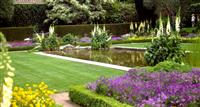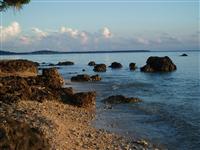Landscape Photography

Whether we live in the countryside or a metropolis, about us we have landscape of one form or another and while those of us who live in a sprawling city may crave the Himalayas, you can guarantee there are country dwellers who desire to see the sights of Manhattan. So, we immediately conclude that Landscape photography can be a diverse and varied subject, we all live in a landscape of one form or another, it is constantly changing, it is easy to access and for the most part it is free to use for photography. Typically it includes such things as natural landscapes, farms, urban landscapes, buildings, seascapes and other bodies of water.
 A good landscape photograph conveys not just the physical shapes in a scene, but also a personal impression (ie. The feelings which are stirred in the photographer when viewing the landscape are transferred to the captured image).
A good landscape photograph conveys not just the physical shapes in a scene, but also a personal impression (ie. The feelings which are stirred in the photographer when viewing the landscape are transferred to the captured image).
Different Approaches
Generally there are three main ways to approach landscape photography:
1. Realistic
Where the photographer attempts to create an obvious and recognisable image of a landscape.
2. Impressionistic
Some realism is compromised in order to create a different mood or impression.
3. Abstract
Landscape features are used to create images of shape, colour, texture and/or tone, which are not clearly recognised as being natural.
These effects are controlled mostly by varying:
The selection of subject photographed
The best landscape photos have a strong and immediate impact
What is Impact?
A successful image will impress and capture the attention of anyone seeing the image: quickly and significantly. Some may like an image, while others may hate the same image; but both will be drawn to look at it; having their attention taken away from everything else that surrounds the image.
- Try to cultivate simplicity, avoiding the inclusion of too many components in the photo.
- Look to compose a photo where a single component dominates
Time of day
Choose different times of day to create different types of images. The same image can look very different at midday to what it does early morning or late afternoon.
Natural Lighting effects
Look for the light filtering through trees and between hills at watch how it falls across the landscape. This may help define the form or highlight interesting areas of the scene.
Simplify
Don’t hesitate to crop an image to make it tighter, exclude unnecessary components to strengthening the attention upon the prime component. Avoid cropping pictures in such a way that will dissect trees or mountains or clouds in the shot. This will be annoying causing the viewer to want to see the other part of that object that is cropped off out of the frame. We want the image viewer eye to wonder around the composition taking in the feeling of the landscape you have captured, not looking for the missing parts but enjoying the whole as a complete framed view of the focal point.
Choice of subject matter
Include people or animals in a scene where it is ‘natural’ to do so, as it may be ‘unnatural’ if it is not done. Be careful to avoid a person or animal becoming the prime focus if it is not the main focus/ purpose of the shot.
A building which has a person in front of it can be appropriate if the building is much larger than the person, and overwhelms the person in the image. It can also add a scale to the photo give an indication of the size of an object in relation to the person size. A silhouette of a person in a sunset may be appropriate where the colour of the sunset is dominant, and the detail of the person is lost so it is no more than a blackened shape contrasting against the coloured light.
Scale
A person in the image can also give you an idea of scale, for example a surfer ready to dive into the ocean from a rock with a huge cliffs in the background, gives a sense of the scale and drama of the scene, as it does to the size of a waterfall or huge tree in a forest shot.
Photographing Streets
Street photos may be posed or candid. Streets are photographed for many different reasons, from tourism brochures to artistic subjects.
A street is a man made environment that can have unique features for the photographer in a number of ways:
- The lighting can be different; with buildings creating greater contrasts in shade and light than what you might find in some other landscapes.
- Legal and ethical issues may be different to other places. People may not want a location exposed (privacy or security issues can become important), and in some places, the ownership of visual images of a place may be protected by the owner of the structure (or garden space) being photographed.
Other features may include for example:
- The actions of people, animals, vehicles etc. moving on the street
- Rubbish or leaves blowing on the pavement
- Street trees blowing in the wind
- Reflections in windows or puddles
- Contrasts between shaded and lighted parts of a street
Tips for Street Photography
Always observe the overall area before you shoot. Consider how the different views will look when shot from different locations, angles, heights in the streetscape and at different times of the day
- Look for images that tell a story
- Communicate with people: approach and ask them about taking a photo of them, gain their position. If you take candid shots of people, be sure you can use images of what you have taken.
- Embrace spontaneity. You can’t plan everything, because a street is a public place and things are constantly changing, whether you want those things in the photo or not, take note.
- Shoot close up and with a blurred background, to get greater control over your subject.
- Telephoto lenses only have limited use. You don’t need to capture everything or things at a great distance in all your shots. Small lenses are sometimes best for street photography.
HOW TO LEARN MORE
Read a book, do a course, join an organisation; talk to people, observe.
Contact us -Talk to an Academic Officer
We provide a FREE COURSE AND CAREER COUNSELLING SERVICE
Learn from our experience.
Books
Our staff have over the years written a large range of book and ebooks, many of which are are available through our school's online book store.
To visit the book store and browse some of these titles, click on any of the books below:
[17/04/2024 09:40:18]